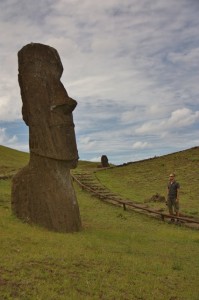 As a kid I once saw a picture of one of the huge Easter Island statues and I got really intrigued. The picture was part of a scientific article dealing with all the mysteries surrounding the island, its people and the statues. I remember my mom made a summary of the article but unfortunately, I had a lot more questions than there were answers in the article. When some time later I saw those intriguing statues appear again in my then favourite Belgian comic book (Suske & Wiske: De Windbrekers), I decided that someday I would travel to the island to find some answers. A look in my world atlas slightly tempered my enthusiasm as this little island seemed to be a bit further away than let’s say Switzerland where we spent our summer holidays and which already seemed to take ages to get to. But some day…
As a kid I once saw a picture of one of the huge Easter Island statues and I got really intrigued. The picture was part of a scientific article dealing with all the mysteries surrounding the island, its people and the statues. I remember my mom made a summary of the article but unfortunately, I had a lot more questions than there were answers in the article. When some time later I saw those intriguing statues appear again in my then favourite Belgian comic book (Suske & Wiske: De Windbrekers), I decided that someday I would travel to the island to find some answers. A look in my world atlas slightly tempered my enthusiasm as this little island seemed to be a bit further away than let’s say Switzerland where we spent our summer holidays and which already seemed to take ages to get to. But some day…
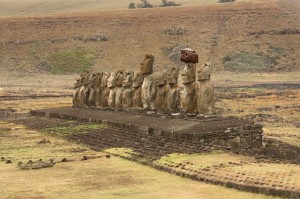 Easter Island or Rapa Nui had been on my itinerary of my 2006 trip but as you know I never made it that far. So when planning this trip it was an absolute ‘must have’. And so more than 25 years after I saw that picture, on a clouded but warm late summer day, we landed at this mysterious island. Although officially the island is part of Chile and Spanish is the main language, it does not all feel like South America at all.
Easter Island or Rapa Nui had been on my itinerary of my 2006 trip but as you know I never made it that far. So when planning this trip it was an absolute ‘must have’. And so more than 25 years after I saw that picture, on a clouded but warm late summer day, we landed at this mysterious island. Although officially the island is part of Chile and Spanish is the main language, it does not all feel like South America at all.
 Which brings us to the first mystery: Where did the people who landed here around 400 AD come from? And how did they manage to reach this extremely isolated island? In the last century some nasty discussions have happened on the origin of the people of Easter Island mostly between the eccentric Norwegian ‘archaeologist’ Thor Heyerdal claiming they came from South America and the majority of the other scientists who claimed they were from Polynesian descent. Nowadays based on genetic and linguistic arguments the consensus is that they were definitely Polynesian. Most probably these people actually made a round trip to the South American continent after their arrival, explaining the mystery of the presence of sweet potato and other typical South American plant and animal species. So they came from Polynesian. But where In Polynesia? Discussions abound… To this day scientists do not agree on the matter. The majority seems to point to the Marquesas in current French Polynesia but heaps of other theories exist.
Which brings us to the first mystery: Where did the people who landed here around 400 AD come from? And how did they manage to reach this extremely isolated island? In the last century some nasty discussions have happened on the origin of the people of Easter Island mostly between the eccentric Norwegian ‘archaeologist’ Thor Heyerdal claiming they came from South America and the majority of the other scientists who claimed they were from Polynesian descent. Nowadays based on genetic and linguistic arguments the consensus is that they were definitely Polynesian. Most probably these people actually made a round trip to the South American continent after their arrival, explaining the mystery of the presence of sweet potato and other typical South American plant and animal species. So they came from Polynesian. But where In Polynesia? Discussions abound… To this day scientists do not agree on the matter. The majority seems to point to the Marquesas in current French Polynesia but heaps of other theories exist.
And how did they get there? Have a look on the map at the distance between the Marquesas and Easter Island. Thousands of kilometres of nothing but Ocean and only this tiny little island, none of the navigation instruments that the big European explores had and using canoes made with tools from the stone age (they did not have metal tools). How they pulled it off? It remains a mystery again. We do know that they would base themselves on among others; the stars, dominant ocean currents, bird flight patterns and cloud formation to navigate to Islands that were far beyond sight, several hundreds or even thousand kilometres away. The details of these impressive skills and knowledge that were passed on by generations for ages, have now long been forgotten and with all the modern technology we are not able to put the puzzle back together.
Today the island’s population is a mix of Polynesian, Chilean and a load of other countries. Given the very limited population it is quite important to introduce some fresh blood from time to time, so ‘mixed marriages’ between islanders and people from all over the world are very much encouraged. The last decades a lot of the old and new inhabitants of Easter Island have started to search for ‘their’ roots and here and there some people even started to talk about independence from Chile. We talked to some people about it and it does not seem that this will happen anytime soon. First of all given that its whole economy is based on tourism and there is hardly any agriculture the island is very dependant of the mother land for survival. Moreover the motherland does whatever it can to keep the people happy. Compared to mainland Chileans, the inhabitants of Easter Island receive huge benefits such as free university education on the mainland (including transport to and living allowances), good healthcare (1 doctor for every 1000 people compared to 1 for every 10,000 on the mainland) with free transport to the mainland if needed. And all this without paying any taxes! No wonder the’ revolutionaries’ have a hard time gathering a ‘critical mass’.
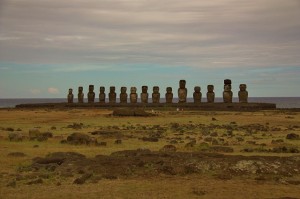 But of course much more than the ‘where do the people come from’ question, most of you are interested in mystery number 2: the statues; what are they, how and why were they made? We found out that here a lot of questions have been answered. Even though none of the theories are bullet proof (there was no written tradition and so no evidence) it is generally assumed that the statues represent the forefathers of a tribe and are part of ancestor worship where the ancestors get a god like status after their death. The statues (forefathers) which were always placed overlooking a village were the guardians of the future and prospect of the tribe.
But of course much more than the ‘where do the people come from’ question, most of you are interested in mystery number 2: the statues; what are they, how and why were they made? We found out that here a lot of questions have been answered. Even though none of the theories are bullet proof (there was no written tradition and so no evidence) it is generally assumed that the statues represent the forefathers of a tribe and are part of ancestor worship where the ancestors get a god like status after their death. The statues (forefathers) which were always placed overlooking a village were the guardians of the future and prospect of the tribe.
How where they made? Here also we have a pretty good idea. Only one tribe living close to the ‘Ranu Raraku’ volcano was responsible for the production of the statues. We visited the site of the volcano, which slopes served as the quarry of all the statues that can be found on the island. It was real industrial mass production. On the slopes of the volcano you can still find hundreds of statues in varying degrees of production. From statues high up on the slopes that were only just started and are still fully attached to the rocks (not an inch of place was wasted) to fully detached statues ready for transport. However all of the images that we saw at the quarry were very basic and rough without the personal features that characterize all the images that we had seen on other statues across the island. The basic process must have been something like this: Step one: industrial production of rough statues that were ‘stocked’ on the slopes of the volcano. Step two: Priests of other tribes come to the quarry /showroom and make a purchase order. The buying tribes were either involved in fishing or agriculture and would pay for the statue accordingly. Step three: transport of the statues to the sites all across the island, up to 25 km away from the quarry. How this was done is still a big mystery. The statues that were made of rather fragile rock and weighed up to 50 ton were somehow delivered without any damage. The only hint we got from stories that survived is that the statues ‘walked by themselves’. All attempts to reconstruct this ‘walking’ have failed. Once the statues were delivered it was time for the fourth and final step in the process: customisation. The rough statues were now refined and personal features and accessories (hats and eyes ) were added. This customisation probably happened by the same tribe that produced the statues.
OK so now we have some idea about where the people came from and why and how the huge statues were produced. But the third, for me definitely most interesting mystery, is why the whole production was stopped from one day to another and why all the existing statues were toppled over or destroyed . It is really clear that something dramatically must have happened and it must have happened really abrupt because we came across numerous statues spread across the island from the quarry that were clearly in transport to one of the villages. In other places you can find statues on which only the ‘final touches’ of customization were missing. It really seemed that someday they dropped their tools and never got back to it again.
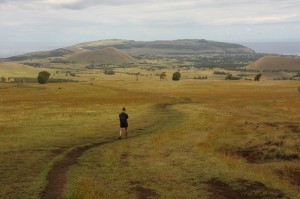 A lot of theories exist. But somehow what I learned on the island was pretty compatible with a theory that seems to me most plausible. Our guide explained us that the society was very hierarchical with one class the ‘long ears’(chiefs, priests and high officers) dominating the ‘short ears’ (workers/slaves). The whole ancestral religion was handled and controlled by the dominant’ long ears’ and it is assumed that their dominance over the slaves was based on this religion rather than on force. For a long time, the slaves would not dare to oppose the ‘long ears’ as they were the representatives of the forefathers/ gods on earth. However one day the slaves had enough of it and they started a revolution. The ‘long ears’ were overthrown and the whole ancestral religion was stopped and with it the production of statues. Seems like a very plausible explanation. Only one point is not very clear: why did the slaves suddenly lose their fear of the ancestors ? Or otherwise put how did the dominant class lose its ‘magic’ ?
A lot of theories exist. But somehow what I learned on the island was pretty compatible with a theory that seems to me most plausible. Our guide explained us that the society was very hierarchical with one class the ‘long ears’(chiefs, priests and high officers) dominating the ‘short ears’ (workers/slaves). The whole ancestral religion was handled and controlled by the dominant’ long ears’ and it is assumed that their dominance over the slaves was based on this religion rather than on force. For a long time, the slaves would not dare to oppose the ‘long ears’ as they were the representatives of the forefathers/ gods on earth. However one day the slaves had enough of it and they started a revolution. The ‘long ears’ were overthrown and the whole ancestral religion was stopped and with it the production of statues. Seems like a very plausible explanation. Only one point is not very clear: why did the slaves suddenly lose their fear of the ancestors ? Or otherwise put how did the dominant class lose its ‘magic’ ?
 That’s where another theory comes into play. I learned about this theory through a chapter in the excellent book ‘Collapse’ by Jared Diamond. In his book he tries to explain the mysteries of how high cultures (Maya, Easter Island, etc) all of a sudden disappeared. His theory on the ‘collapse’ of Easter Island is that it concerned a complete ‘ecocide’ or ‘end of the world’ on a small scale. We know that the population at the time of the ‘revolution’ was a lot bigger than it was today and a lot more than the island could support . Too many people meant that all resources were getting depleted very fast until they finally ran out. The island that used to be full of trees and birds was found completely without any tree or bird by the first European explorers. The erosion that followed the deforestation hugely impacted agriculture and food began to become scarce. Lack of food meant very hard times due to famine and intertribal wars. It seems that to counter these hard times the ‘ancestor religion’ was put into an even higher gear. The last statues that we saw ‘in production’ at the quarry were clearly a lot bigger (between 10 and 20m high)than the ones that can be seen all around the island (between 3 and 7m). Bigger statues to please the ancestors, hoping that they would bring better times? Unfortunately this probably only made matters worse as more wood was needed to build the bigger statues. People were dying everywhere and of course the ‘short ears’ were hit the worst.
That’s where another theory comes into play. I learned about this theory through a chapter in the excellent book ‘Collapse’ by Jared Diamond. In his book he tries to explain the mysteries of how high cultures (Maya, Easter Island, etc) all of a sudden disappeared. His theory on the ‘collapse’ of Easter Island is that it concerned a complete ‘ecocide’ or ‘end of the world’ on a small scale. We know that the population at the time of the ‘revolution’ was a lot bigger than it was today and a lot more than the island could support . Too many people meant that all resources were getting depleted very fast until they finally ran out. The island that used to be full of trees and birds was found completely without any tree or bird by the first European explorers. The erosion that followed the deforestation hugely impacted agriculture and food began to become scarce. Lack of food meant very hard times due to famine and intertribal wars. It seems that to counter these hard times the ‘ancestor religion’ was put into an even higher gear. The last statues that we saw ‘in production’ at the quarry were clearly a lot bigger (between 10 and 20m high)than the ones that can be seen all around the island (between 3 and 7m). Bigger statues to please the ancestors, hoping that they would bring better times? Unfortunately this probably only made matters worse as more wood was needed to build the bigger statues. People were dying everywhere and of course the ‘short ears’ were hit the worst. 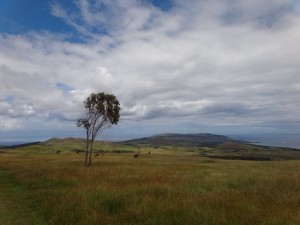 Seeing that all attempts to please the ancestors/gods failed and seeing their friends and family die all around, the slaves in the end must have figured they had nothing to lose from revolting against the dominant class and indirectly against the ancestors/ gods. They took up arms, kicked out the ‘long ears’ and started to destroy and topple over everything that represented the former dominant class; the most obvious being the huge statues all over the island. Wars and famine must have continued for years until the population reached a level that could be supported by the island, at just a small fraction of the population of the ‘good times’. Today the island still suffers from the destruction of the environment that happened at those times. Some trees have been replanted but as a whole the island is very barren and erosion is still a huge problem. After each tropical rain shower the ocean turns brown and red from soil that have been washed away.
Seeing that all attempts to please the ancestors/gods failed and seeing their friends and family die all around, the slaves in the end must have figured they had nothing to lose from revolting against the dominant class and indirectly against the ancestors/ gods. They took up arms, kicked out the ‘long ears’ and started to destroy and topple over everything that represented the former dominant class; the most obvious being the huge statues all over the island. Wars and famine must have continued for years until the population reached a level that could be supported by the island, at just a small fraction of the population of the ‘good times’. Today the island still suffers from the destruction of the environment that happened at those times. Some trees have been replanted but as a whole the island is very barren and erosion is still a huge problem. After each tropical rain shower the ocean turns brown and red from soil that have been washed away.
Not compatible with the romantic image you had of Easter Island? Well, seeing the remains of it all definitely made us think about what is going on with our planet on a much larger scale…
For people that have gotten intrigued and want to visit the island, one suggestion: take a 1 day guided tour to get introduced to the island and the main sites and go explore on your own afterwards. That’s what we did. Despite our decision not to ride bicycles anymore, we did rent some again and went looking for some of the sites. And they really are everywhere. Most of them are completely in ruins but a lot of them have been beautifully restored. Actually all of the statues that are standing up today have been restored during the last 50 years. In ruins or restored, we found them all really impressive to look at and to be around, probably even more so after some of the mystery and romance had disappeared through what we learned.
And when you get bored of checking out all the statues, you can climb the tree main volcanoes that shaped the island. The views over the island and the vast ocean are spectacular and there are wild horses roaming all across the island. The ‘Rano Kau’ volcano especially is really impressive with its crater right next to the cliffs and next to it the main site of the new but less spectacular religion of the ’bird man’ that appeared after the crisis.
Unfortunately due to flight constraints with LAN Chile ,we only had about 3,5 days on the island so we did not find the time to go diving or to catch some of the waves of the island. If you decide to go there make sure you have at least 5 days. A week would be even better.
From Easter Island we hopped on a midnight flight that would take us about 4000 km further into the South Pacific to Pape’ete the capital of Tahiti & French Polynesia.
[ad-gallery orderby=”menu_order” width=”550px” height=”300px” imagedesc=”none”]

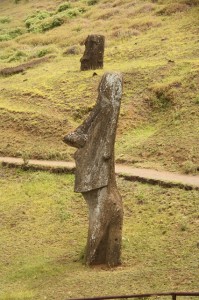
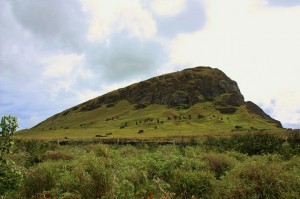
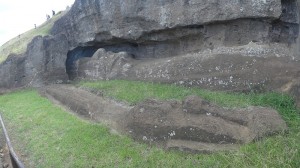
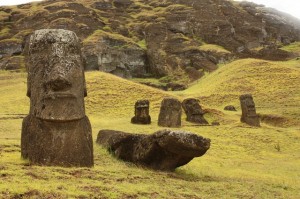

Prachtig verhaal… het doet mij denken aan het nieuwsgierige kind dat je was… hoe je het boekje”waarom is de hemel blauw?” verslond…. behou je interesse en blijf ze delen met ons. We kijken al uit naar de volgende blog. Er ligt hier alweer sneeuw ondertussen: het vierde winteroffensief. Leen is gisterenavond kampioen geworden met haar bloritten… de bieslook priemt al door de sneeuw… de lente is op komst.
dikke knuffel
Mamaroos
Dankjewel voor de antwoorden op al m’n Paaseiland-vragen 🙂 Heel erg interessant! Als kind was ik ook in de ban van De Windbrekers! Er bestond daar ook een Sus & Wis poppen/tekenfilm van… Keek kleine Jantje daar voeger ook naar op den BRT? :p
Benieuwd naar jullie volgende jaloersmakende avonturen in Bora Bora! X
guur, ruig, speciaal, magnifiek… echt ik blijf ook wel een beetje jaloers op al jullie machtige verhalen hoor!
super hé! We willlen er zeker ooit nog eens passeren maar dan met wat meer tijd…